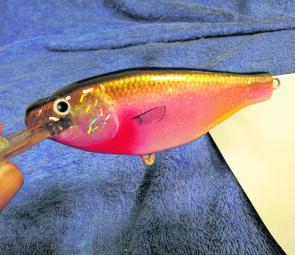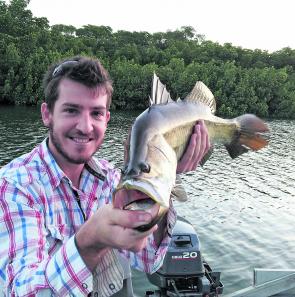Before I start I would like you to clear any preconceptions or negative experiences you associate with technology. For some, the word alone feels too new age, hi-tech and nerdy. In this article I hope to shine some light on an exciting new possibility which combines technology and fishing.
Forget about the last time your computer crashed or contracted some sort of Trojan virus thingy from Nigeria. This will change the way you think of technology and how this process alone could revolutionise fishing. I’ll do my best to limit the use of Shelden Cooper terminology, however trying to keep it brief and informative has been a challenge in itself, so try to hang in there.
It is 3D printing and the concept is printing fishing lures. It is set to transcend the evolution of lure prototyping. I know it probably sounds crazy and the idea is even more obscure. Just like it suggests, it is the printing of a fishing lure. It is not ink to paper two dimensional. I’m talking about watching your lure come to life, real to touch and solid three-dimensional.
Why might you buy such a machine when you can just walk in and buy a lure? Well, I’m not here to sell you one nor convince you, it is simply the concept that makes it appealing and groundbreaking. This process of lure making allows you to walk away and return to find your lure 95% done. For prototypes you can simply tie on and swim test. For the fully finished article; gluing in the internal wiring and bib placement as well as airbrushing is still required.
To clarify, this is more for the visionary lure developer looking to push the boundaries and express his or her creativity. This process enables each lure to be replicated with precise accuracy. It does this by completely eliminating shape flaws and inconstancies from one lure to the next.
For the purist’s, there is no substitute for a wood carved lure and I would have to agree on most occasions. I am a firm believer that the material density is one of the most contributing factors and not the buoyancy or weight. If the lure is the right balance, the cadence created by the lure passing through the water will create the desired action. This will entice a feeding strike or reaction strike which is triggered by vibrations that stimulate the lateral line on the fish. For example, a feeding strike may see the lure hook the fish inside or around the mouth. A triggered strike might be a bump or slap on the lure and hook the fish on the cheek or head. They might not be hungry however killer instinct will overwhelm the fish into hitting the lure. Barramundi are a great example in that they can be annoyed at times into hitting a lure. So how does this relate to 3D printing? Well the process allows you to control the density of the lure. You can even create moulds from this technique if you want to try different materials or even soft plastics.
Designing your own lure, envisioning it before being produced is possible through the 3D modelling software. This process is remarkably accurate and it can eliminate the time spent shaving off flakes of wood or even skin sometimes. This creativity is one of the main advantages with 3D printing, as it provides a different creative field. There are a number of available software programs that are used for developing a mathematical representation of the surface of any three dimensional object, also called 3D modelling. Autodesk produce a number of quality high end programs that are used on a commercial scale. I use a program called Autodesk 3Ds Max. Autodesk also have Maya and 123D. I have also used AutoCAD and Cinema 4D that all do virtually the same thing.
The printing side of this process is easy; the more challenging part is modelling your creation. Unless you have some of the basic skills and techniques you might need to spend a few hours up skilling in one of the many available 3D modelling programs.
If I can teach it to year 10 students then I’m sure anyone could give it a go. Furthermore, the great wonder we call YouTube can help solve most problems and enables you to become a self-taught expert if you are prepared to give it a crack.
Software has become so advanced you can scan images and video footage before modelling an exact clone of the desired subject. Known as 3D scan software, it can replicate a very accurate model with very little work on your part. This could be another real possibility, however unless you have a basic understanding of some techniques, manipulating this model may be challenging. I suggest you have a look at this amazing scanning software on YouTube. Type in 3-Sweep: Extracting Editable Objects from a Single Photo. Some of the new 3D Scan software is worth checking out, just do a search through Google.
3D printing, also known as additive manufacturing, is a process of making a three-dimensional solid object of virtually any shape from a digital model.
It is achieved using an additive process, where successive layers of filament material are laid down layer by layer. The filament comes out hot and builds upon the previous layer similar to a hot glue gun or chefs piping bag used for layering cream or icing. Slowly but surely each layer is built up by a fraction of a millimetre at a time..
This technology is used for both prototyping and distributed manufacturing with applications across architecture, engineering, construction (AEC), industrial design, automotive, aerospace and military. Only recently there have been reports of 3D printers printing with stainless steel. Other dental and medical industries such as biotech (human tissue replacement) are also taking advantage of its many abilities. Yes they are even printing out body parts.
The lure will not be ready to cast straight away. It is merely a modelled plastic shell. You will still need to lightly touch up any rough edges with sand paper before painting and finishing. Also, I would not rely on the strength of the resin filament for the bibs to stand up to quality fish. Having witnessed barramundi do obscure things to all kinds of lures I would trust they would treat these no differently.
Another great concept is printing out casting moulds for setting your hardbaits. This could be another article in itself and would enable lure developers to create a hard or soft plastic lure on a solid platform to enable resin or foam to be poured into.
Similar to lead sinker creation, separating the two cast sides will in theory leave the set lure for you to finish. I have already tried this method and I believe it to be more successful than any other. If you find the right resin or foam you can achieve outstanding results. You may need to play around with buoyancy levels, so be prepared to tinker around. Microballoons are a must if using a resin with high density. There is a great new casting foam from Alumilite called Alumifoam - strong, durable and dries fast.
So, you want to look into it or you are seriously thinking about buying one. For such an investment you would need to take into consideration its purpose for you or your business. If you are not prepared to learn the software or cannot find someone to design models for you, don’t bother. It will gather dust quicker than Bernard Tomic’s Australian Open exit. However, if you are interested in exploring alternative design avenues maybe this could be for you.
The machines I’m familiar with are the Cube from Cubify and the Replicator and Replicator 2 from Makerbot. Both are made in America and seem to all have good reviews. I use two Cube printers and have had no problems at this stage. They are simple and easy to use, simply save your file to a usb(storage device) and insert into the printer and be mesmerized. So what price are we talking about? You can pick up 3D printers for anywhere from fifteen hundred to five thousand big ones. I’m sure you could do better on ebay or similar but be careful. Filament costs approximately $50 a spool. The amount of jobs you will get will depend on your machine and job size. For example, it is possible to create approximately 30 shad style lures from one spool of filament. The filament is available in a range of different colours which can be intriguing, however if you are airbrushing over the top of the lure this is not a concern. You can purchase illuminate glow in the dark filament which makes for some interesting ideas.
I would like to leave you with this thought. How many lures could you make while you are out fishing? That’s right, while you are out doing something else. While the 3D printer is doing the hard work, you can be away painting your other lures, modelling other designs on the computer or even swim testing your prototypes in field! How good is that, you don’t even need to be there! Working smarter and not harder has never made so much sense!
Reads: 11764
The software enables you to create an exact profile of any baitfish. Above the Baitfish image you can see the rendered 3D model.

Here you can see the printer head laying down the first support layers of green filament

Here are two printed prototypes. One still has the support structures attached. The other has them removed and will require light sanding.

The finished article after airbrushing and finishing, ready for combat!

Originally interchanged for a quick swim test it grabbed the attention of an eager barramundi from right under the boat




